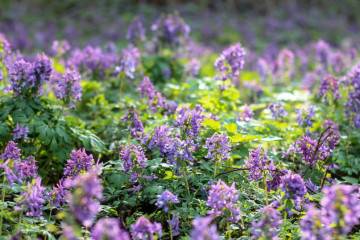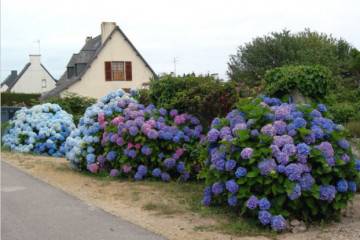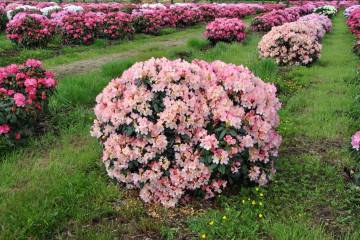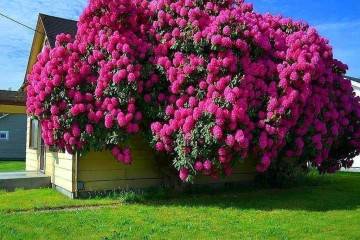Low-growing shrubs - flowering and deciduous for the garden
Content:
- Undersized shrubs
- Short curb shrubs: perennial
- What shrubs are used to make hedges
- Perennial shrubs blooming for summer cottages
- Ornamental shrubs for Siberia
- Ornamental shrubs for the Urals
- Flowering shrubs for the Urals
- Shrub and perennial mixborder
- Mixborder schemes from shrubs and perennials
- Mixborder with hydrangea
- Mixborder with hydrangea and conifers
- Ground cover shrubs
Landscaping traditionally uses crops that form dense thickets. Among them, a special place is occupied by numerous varieties of border shrubs with monochromatic, colored and decorative foliage. Among them are deciduous, evergreen, herbaceous, flowering, berry, fruit bushes.
Undersized shrubs
The category of undersized include low bushes with shoots up to 1 meter high. To decorate the garden, choose:
- conifers, they are good at any time of the year;
- evergreen with leathery leaves;
- changing the color of foliage by autumn;
- with fringed, red, two-colored, carved, clawed, umbellate leaves;
- different flowering periods;
- decorative fruits, berries.
Bushes grow well in open ground, capable of:
- create compositions yourself;
- serve as a background for other plants;
- form a hedge;
- decorate flower beds and parterre lawns.
We will talk about the varieties further.
Short curb shrubs: perennial
The recommended height of the bushes acting as a curb is from 25 to 60 cm.
Among the low-growing shrubs for the border, perennials are looking for, slowly growing and unpretentious in care.
When choosing planting material for borders, preference is given to:
- winter-hardy varieties that do not require shelter;
- not demanding on the composition of the soil, acidity;
- growing in shade and partial shade
- resistant to moisture deficiency.
Low-growing shrubs that do not require regular formative pruning:
- tunberg barberry: a variety of bagatelle with purple foliage, spherical crown. Annual growth of shoots is no more than 2-3 cm; kobol, leaves by autumn change color to yellow or orange.
- Japanese spirea, Golden Princess variety, forms a compact bush up to 50 cm high.
- euonymus of the subspecies forchun with elongated pointed leaves with a yellow edging - grows slowly, forms an even spherical bush.
- caragana dwarf grows in width up to 2.6 meters, height 30-60 cm. All summer keeps yellow buds, blooms profusely.

Spirea grefsheim, planted at the facade, will become a decoration of the house. Differs in long flowering, grows up to 80 cm tall
What shrubs are used to make hedges
Among ornamental deciduous plants for the garden, crops are chosen that form dense crowns. A hedge must protect from dust, dirt, noise, prying eyes. Designers distinguish two types of hedges:
- unformed, carry out only sanitary pruning, remove old, crooked shoots, dry branches;
- decorated, the bushes are given a geometric shape.
Several fast growing shrubs used for fences:
- dogwood grows from 2 to 5 meters, tolerates pruning well, shade-tolerant. Growth up to 30 cm per season. Fruiting, edible berries;
- bladder with leaves like viburnum grows up to 4 meters. Blooms in June, fruits and leaves change color by autumn. Growth 40 cm;
- evergreen thuja with the names Brabant and Smaragd are cold-resistant plants, they tolerate frosts down to -15 ° С. Height from 2 to 4 meters. Suitable for wall planting. Growth 30 cm per year;
- shade-loving juniper, it is planted on the western and northern sides of the site. For the hedge, cone-shaped varieties are chosen. Growth up to 25 cm per year, starting from the 3rd year of growth.
Berry trees are used for the hedge:
- rose hips are well acclimatized in any conditions, fragrant during the flowering period;
- raspberries planted in a row up to 60 cm wide, hide from prying eyes, delight with the harvest;
- blackberries braid mesh fences, bear fruit well on the sunny side;
- honeysuckle, grows up to 1.5 meters, bears fruit at the end of June, retains its decorative effect throughout the season, can be pruned.
Perennial shrubs blooming for summer cottages
There are many varieties of herbaceous and tree-like shrubs, they are chosen for their resistance to climatic factors. It can be:
- finicky roses;
- bulbous and root irises;
- bush Japanese lily, releasing yellow phonographs on a long arrow;
- phloxes of different flowering periods, cap shapes;
- panicle and globular hydrangeas;
- argiranthemum, growing and caring for which at home does not require much effort.
Ornamental shrubs for Siberia
Ornamental shrubs that are suitable for Siberia:

Elderberry Black Beauty is an example of a perennial garden shrub for areas with severe winters, return frosts
- white dogwood or svidina of the dogwood family is distinguished by branching, it grows up to 3 meters. Leaves edged, dark green, dense;
- elderberry is prized for its carved leaves, which change colors in late autumn, and fruit clusters. Breeders have developed varieties with colored greens;
- spireas in species diversity: pyramidal; in the form of hemispheres; liana-like with sprawling long shoots that can lean on a support;
- cold-resistant types of barberry: varieties of tunberg; Amur; ordinary fruiting; Ottawa.
- Potentilla or Kuril tea is winter-hardy, blooms profusely, the color of the buds is yellow or white.
Ornamental shrubs for the Urals
You can plant plants for Siberia, central Russia. Among the ornamental shrubs for the Urals, the attention of gardeners deserves:
- irga canadian;
- Japanese kirea;
- snowberry;
- chubushnik;
- Japanese velvet.
Flowering shrubs for the Urals
They are especially variegated, abundant flowering:
- perennial shrub aster;
- varieties of argiranthemum shrub or "alpine daisies";
- chrysanthemums or evening primrose shrubs from the fireweed family.
In the Ural conditions, most of the perennial shrubs that bloom in summer survive, used in landscape design for giving and decorating parks. Many hibernate without shelter.
Shrub and perennial mixborder
Complex flower beds of continuous flowering are called mixborders.Plants bloom at different times; special schemes are drawn up for bush planting.
Mixborder schemes from shrubs and perennials
When laying out, take into account which side the site is viewed from. Schemes are:
- double-sided, trees, tall bushes are planted in the center, border plantings are made on the sides;
- one-sided, when crops are planted for growth, high background for low.
When placing perennials, layering is observed so that the plants do not shade each other. Microsorbers are viewed from a distance, there should be bright color accents. The flower bed can be of any shape, from round and rectangular to intricately curved.
Mixborder with hydrangea
The flower does not like the bright sun in the afternoon; tall neighbors are picked up to it, giving an openwork shade. Hydrangea is supplemented with shrubs with decorative foliage: heucheras, hosts, ferns.
Among flowering crops, lovers of acidic soil are chosen:
- azaleas;
- badan;
- Japanese lilies;
- peonies;
- rhododendrons;
- astilbe.
Large-leaved flower varieties are planted in the center of the composition, along the edges - dwarf species. From tall shrubs of spring flowering, chubushnik, weigela, spirea, barberries are chosen.
Mixborder with hydrangea and conifers
The flower grows well in acidified soils. The needles discarded by ephedra serve as a deoxidizer, baking powder and drainage at the same time. In the vicinity of conifers, hydrangea care will be simplified. Flower bushes are planted next to spruces, junipers, thujas, firs, pines.
Ground cover shrubs
In creeping crops, the roots do not deepen, they creep under the surface, and germinate with new shoots. A feature of ground cover shrubs is the ability to quickly fill free space. When choosing beautiful unpretentious shrubs, take into account:
- exactingness to the ground. The intensity of plant growth depends on the correctly chosen planting site;
- frost resistance. It is not customary to cover curbs, areas with stones entwined with ground cover crops;
- resistance to diseases, pests;
- flowering time.
Ground cover shrubs are coniferous, herbaceous, liana-like, giving shoots up to 5 meters long. Perennials displace weeds from the occupied area, strive to seize new territories. In addition to the aesthetic function, they are practical, they rid the earth of clogging. Ephedra are compact and grow slowly. Herbaceous are distinguished by good growth, delight with flowers.
For sunny places from cereals, all types of fescue are applicable, from blooming sun-loving perennials they choose:
- alissum;
- splinter;
- blue carnation with an original shade of greenery;
- catnip, better known as catnip;
- dwarf phlox;
- ground cover asters.

The white cap of Iberis is formed during flowering, the rest of the time the evergreen snowflake pleases with beautiful foliage
Shade-tolerant plants are planted in shaded areas:
- blue periwinkle;
- a cuff with decorative leaves in the form of umbrellas;
- tenacious creeping with sultans of inflorescences;
- hosts with colored greenery;
- large-leaved brunners;
- white clover, it braids everything in its path.
There are no definite canons in landscape design; the owners of suburban recreation areas decorate the territory to their liking. Crops matched to climatic conditions require minimal maintenance. They need to be formed, periodically fed, then the site will turn into a piece of paradise.




















